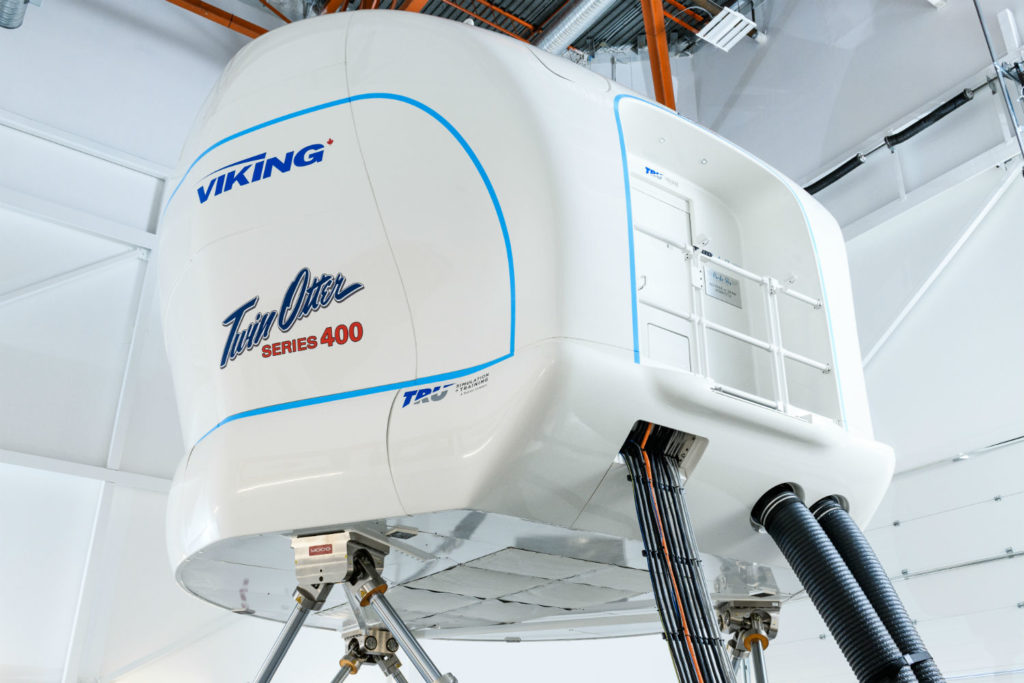Estimated reading time 4 minutes, 31 seconds.
On Dec. 21, 2017, an industry milestone was achieved with Transport Canada’s approval and qualification of the world’s first “Level D” Twin Otter simulator for Pacific Sky Aviation in Calgary.

Designed and built by the Montreal branch of TRU Simulation + Training, the Viking Twin Otter Series 400 simulator faithfully reproduces the characteristics of the iconic Canadian twin-turboprop utility aircraft, both on wheels and amphibious floats.
“The exciting aspect of this Twin Otter simulator is the integration of water, air and ground models,” said Michael Coughlin, CEO of Pacific Sky Aviation, in an interview with Skies. “There was a lot of groundbreaking work done by TRU, with support from Viking and Canada’s National Research Council, to understand and develop the physics about how the amphibious Twin Otter performs.”
Level D simulators have the highest capabilities of any full flight simulator (FFS), allowing pilots to obtain type ratings in sophisticated aircraft, with zero time spent flying the actual plane.
The realism of a Level D sim has to be experienced to be believed, with incredibly detailed visual displays, a full-motion base that responds to the pilot’s inputs, and accurate sounds for every phase of flight.
A marriage of marine and aviation simulation technology was critical to give pilots a realistic training environment that includes both air and water operations in the Twin Otter.
“The simulator has all the features of a Level D simulator in the wheeled version which are going to delight our customers. Beyond that, it will have seaplane capabilities to replicate undocking, water taxi, takeoff and landing–with a variety of wind and water conditions, docking and ramping, and wheeled amphibious taxi operations,” said Coughlin.
Since no regulatory standards currently exist for qualification of a seaplane sim, Coughlin explained that while the sim will initially be Level D qualified only in the wheeled configuration, “Pacific Sky is in discussion with several regulators, and there is a high interest in pursuing this project to establish the standards for seaplane qualification.”
Victoria’s Viking Air Ltd. has built more than 135 new Twin Otter Series 400s since restarting the aircraft program in 2007, with about 20 per cent operating on floats. Given such a small base, the huge investment needed to create the sim might be difficult to justify.
Not so, explained Dave Curtis, president and CEO.
“The business case for a Twin Otter full-flight Level D simulator is strategic and long term. As the OEM, this makes sense to us. This investment will help promote sales, increase safety and protect the Twin Otter brand,” he said.
Operators of “classic” series 100, 200 and 300 Twin Otters are also interested in Level D training. And with markets emerging for the plane in locations such as China, Viking can help operators make a smooth and safe entry-into-service for new Twin Otter fleets.
“We wanted to be able to offer our customers the highest possible training experience that would enhance operational safety. We also knew that pilot shortages were looming, and our operators would benefit from the training offered by a simulator to help produce pilots needed for their operations,” said Curtis.
Also based in Victoria, Pacific Sky Aviation is Viking’s training partner for the Twin Otter and the worldwide fleet of Viking CL-215T and CL-415 water bombers.
While floatplane pilots will train in simulated, high-resolution reproductions of Victoria and Vancouver harbours, and on nearby Cowichan Lake where glassy water landings can be practiced, Coughlin said that pilots will still need actual time in a float-equipped Twin Otter.
“Pacific Sky will soon be able to train pilots on various seaplane techniques under a variety of conditions. But due to the challenges of real-life operations, actual on-aircraft training will still be required for customer-specific seaplane operations,” he said.
Watch out for that kayak!
Very interesting…….I guess you are the expert instructor